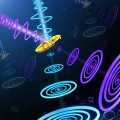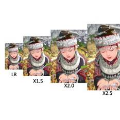This paper proposes a quantum computing-based algorithm to solve the single image super-resolution (SISR) problem. One of the well-known classical approaches for SISR relies on the well-established patch-wise sparse modeling of the problem. Yet, this field's current state of affairs is that deep neural networks (DNNs) have demonstrated far superior results than traditional approaches. Nevertheless, quantum computing is expected to become increasingly prominent for machine learning problems soon. As a result, in this work, we take the privilege to perform an early exploration of applying a quantum computing algorithm to this important image enhancement problem, i.e., SISR. Among the two paradigms of quantum computing, namely universal gate quantum computing and adiabatic quantum computing (AQC), the latter has been successfully applied to practical computer vision problems, in which quantum parallelism has been exploited to solve combinatorial optimization efficiently. This work demonstrates formulating quantum SISR as a sparse coding optimization problem, which is solved using quantum annealers accessed via the D-Wave Leap platform. The proposed AQC-based algorithm is demonstrated to achieve improved speed-up over a classical analog while maintaining comparable SISR accuracy.
翻译:本文提出了一种基于量子计算的算法来解决单幅图像超分辨率 (SISR) 问题。SISR 的一个众所周知的经典方法依赖于该问题的基于补丁稀疏建模的成熟方法。然而,当前该领域的状态是,与传统方法相比,深度神经网络 (DNNs) 展示了更优秀的结果。尽管如此,量子计算预计将来越来越重要的机器学习问题。因此,在这项工作中,我们有特权对这个重要的图像增强问题,即 SISR,进行早期探索,即应用基于量子计算的算法。在量子计算的两种范式中,即通用门量子计算和绝热量子计算 (AQC),后者已成功应用于实际计算机视觉问题,其中利用了量子并行性来有效地解决组合优化问题。本研究展示了将量子 SISR 形式化为基于稀疏编码优化的问题,该问题使用通过 D-Wave Leap 平台访问的量子退火器解决。所提出的基于 AQC 的算法被证明在保持可比较的 SISR 精度的同时实现了改进的加速。


